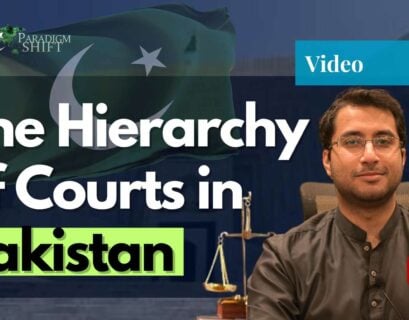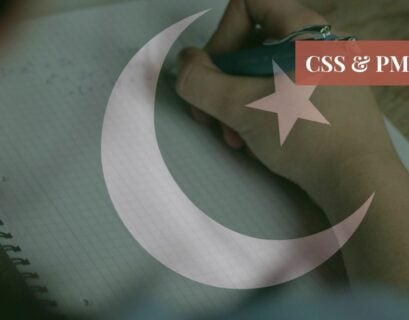Ms Mehwish Batool is a recent law graduate from LUMS. She works at the office of the Attorney General for Pakistan.
Introduction
Public interest litigation is a brainchild of modern industrial society whose hallmark is mass production and mass consumption which led to the ‘massification’ of society. This started problems that were practically unrevealed in the past and led to the replacement of old individual rights with social rights. This shows that in the past the accentuation was on ‘individuality’ while ‘collectivity’ is the concept of today’s world that helps in the development or enhancement of the notion of public interest litigation.
Public interest litigation is elaborated as non-formal remedial litigation that is not initiated for the assistance of one individual but for the benefit of an oppressed or exploitative class who are denied their constitutional rights and helps them to have access to the court for the enforcement of their fundamental rights.
In Muntizma committee v. Director Katchi Abadi Sindh (PLD 1992 KHC Sindh), the court defined public interest litigation as ‘not a means to satisfy the curiosity of the people but a litigation which is instituted with a desire that the court would be able to give effective relief to the whole section of the society’. Thus the basic rationale behind this concept comprehends that public interest litigation should be able to overcome the defects and shortcomings of the adversarial legal system which intercepts vulnerable groups of a society to take benefits from law and justice.
Evolution of the Concept of Public Interest Litigation
In Pakistan, the concept of public interest litigation developed into four stages. The first stage is the ‘activist phase’ which was aimed at the relaxation of standing for unrepresented interests. In this phase, the judges must listen to the injustices of vulnerable people in order to prevent lawlessness, corruption, and law of the jungle in society.
The second stage consists of the realization of the judges to throw open the restrictive gates of locus standi for the aggrieved person. This can be seen in the case of Benazir Bhutto v. Federation of Pakistan (PLD 1988 SC 416) and a leading case of Darshin Masih (PLD 1990 SC 513) which are considered pioneering cases of public interest litigation.
The third stage began to show up the limitation of public interest litigation in terms of procedural relaxation and such issues have been discussed in Ardeshir Cowajee v. Multiline Associates, Karachi (PLD 1990 SC 513). The fourth stage alters the focus of Public interest litigation and shifts to petitions which defend one private interest against another. This appears in Benazir Bhutto v. Federation of Pakistan (PLD 1988 SC 416) which shifted the focus of petitions from vulnerable groups of society to individual private interest.
Constitutional Foundations of Public Interest Litigation
Article 4 declares the right to the protection and equal treatment of citizens in accordance with the law. In addition to that, Articles 8-28 provide the constitutional guarantees of the fundamental rights of all citizens and also declared that any law which is inconsistent with these rights is considered null and void.
The important constitutional questions related to public interest litigation include the jurisdiction of the Supreme Court to act as a protector or guarantor of the fundamental rights of citizens provided under constitution Article 175 (2) of the Constitution and Article 184 provides jurisdiction to the Supreme Court to make decisions on the matters of public importance with reference to any of the fundamental rights.
The jurisdiction of the Supreme Court under Article 184(3) is not dependent on the concept of aggrieved party as in the context of the adversary proceedings. Thus the Supreme Court further loosened the traditional rule of the aggrieved person or locus standi.
As explained in Article 184(3), the Supreme Court can only take notice of those matters which contain elements of public importance which are defined as matters which affect the whole body or people of an entire community (Khan, 1993). Thus through the relaxation of the stringent requirements of adversarial procedures and an adaptation of non-formal procedures such as letters, telegrams, media, and newspapers, the courts have revolutionized the judicial process into more encompassing or inclusive (Rizvi, 1991).
The growth of public interest litigation and democratization of justice reached its climax during Justice Chaudhary Iftikhar’s era who had taken hundreds of suo moto actions and entertained 450 constitutional petitions, but his successors have adopted a more conservative approach while entertaining constitutional petitions related to public interest matters and specially suo moto actions.
On the other hand, the apex court in the post-Chaudhry Iftikhar era has also given landmark judgments related to public interest matters to democratize and liberalize the concept of justice so that every section, howsoever, lowly occupied and downtrodden gets an equal chance to get a fair deal.
Protection of Fundamental Rights
To Ensure Merit
The court has used the ambit of public interest litigation in different spheres to protect the fundamental rights of citizens and to ensure merit or banish the elements of corruption from society such as in Syed Mubashir Raza Jaffari v. EOBI (PLC 2014 SC 428) when the court took notice of the violation of fundamental rights of citizens at large by a public body EOBI in the manner of selections and appointments based on political influence, nepotism, and cronyism.
The court stated that the aggrieved person not only presents his individual right but this case was also concerned with the rights of more than 23,127 who had applied for jobs in this public institution and had their applications passed over due to nepotism and political pressure.
Similarly, the court has also used the same analogy of protecting the fundamental rights of citizens through the legal framework of Article 184 (3) in Muhammad Akram v. Registrar Islamabad High Court (PLD 2016 SC 961) in which the appointments in Islamabad High Court were made in colorful exercise of power or by rejecting the transparent process of recruitment provided under the relevant service rules. This act of power would have far-reaching undulate effects on the public at large which resulted in depriving meritorious citizens of the opportunity of competing for public offices on merit.
The apex court of the state has also used the rationale of public interest litigation in protecting the fundamental rights of underprivileged sections of the society by taking suo moto action against the eviction of I-11 residents of Katchi Abadi (Malik, 2015) from their homes who were deprived of their fundamental rights to life, equality, dignity, shelter, and due process as guaranteed by the constitution under Article 9, 10A, 14,15, 24 and 25 respectively.
To Protect the Environment
The mechanism of public interest litigation is not only used to protect the rights of the citizen but has also been used in environmental litigation for the development of environmental law.
In Lahore Bachao Tehrik vs. Dr. Iqbal Muhammad Chauhan (2015 SCMR 1520), the Apex court took action regarding the cutting of trees for widening activities proposed by the provincial government due to traffic congestion problems and bottlenecks on the Lahore Canal Road. It granted permission on the condition that during widening activities there would be a minimal intrusion to the environment and for each tree cut as a result of proposed construction activities, the provincial government had to plant ten trees so that cutting of trees would in no way be hazardous for the environment.
With the increasing confidence of the nation over the judicial forum, people are coming up with issues towards the court which require unconventional remedies from the courts and question the fact if it really comes under the realm of consumer protection or of environmental law. However, the courts have proved that it should not really matter because both angles could fall under the jurisprudence as elaborated in Shehla Zia v WAPDA (PLD 1994 SC 693) case.
To Provide Basic Necessities
In Shahab Usto vs. Government of Sindh (2017 SCMR 732), a constitutional petition was filed before the court to ensure basic necessities such as clean drinking water and a safe environment for the people of the province of Sindh. The court formed a commission to record findings about the supply of clean water to the residents of the respective province along with the deteriorating conditions of sanitation. Footage of waste or polluted water flowing into canals or channels was found which resulted in severe environmental hazards and human suffering.
To Protect Endangered Species and Preserve Wildlife
Along with the protection of the environment, the court also has also used its judicial powers to protect endangered species and preserve wildlife through the Province of Sindh vs. Laal Khan chandio (2016 SCMR 48).
The court took notice of the license granted to foreigners by the provincial government to hunt Houbara Bustard whose status was designed by experts as vulnerable and threatened and the evidence showed that the species of Houbara Bustard was declining.
Thus through the framework of public interest litigation, courts are not only taking action regarding the fundamental rights of the citizens but also seeking to prevent the decimation of endangered species from the machinations of federal and provincial governments.
To Protect Minorities
In PLD 2014 SC 699, the court took suo moto action through the petition filed by an NGO “Justice Helpline” regarding the Peshawar church attack and other petitions filed by the Hindu community against the desecration of their places of worship. The court issued a landmark judgment on the decision of minorities and freedom of religion and proposed different measures to promote a culture of religious and social tolerance.
Similarly, to establish a precedent for promoting religious tolerance, the court took suo moto action against Kot Radha Kishan lynching case (Haider, 2014) in which a Christian couple had been falsely accused of tossing out pages of the Holy Quran, later brutally killed and thrown alive into the brick kiln. The court passed the death penalty for five and two years’ imprisonment for eight individuals in order to protect the rights of minorities.
To Make Public Officials Accountable
In Anjum Aqeel Khan vs. National Police Foundation (2015 SCMR 1348), the Supreme Court ordered NAB to initiate proceedings against the Board of Directors and Administrative committee of the National Police Foundation who were involved in irregularities and corruption in the launch of the National Police Foundation Housing Society by the National Police Foundation for poor police officials.
These kinds of cases have not only restored the faith of the general public in the transparency of the judiciary but have also made the judicial process the panacea for all the problems of the public in developing countries like Pakistan and India.
To Promote Culture & the National Language
The realm of public interest litigation has also been used for the preservation of national integrity and sovereignty through the adoption or promotion of the use of the national language Urdu as the official language of the state to help citizens understand everything within their own culture and language.
In Muhammad Kowkab Iqbal v. Government of Pakistan (PLD 2015 SC 1210), the court stated that in the governance of the federation and provinces, there was hardly any necessity for the use of a language other than Urdu which cannot be understood by the majority of the people of the state. Moreover, the court also ordered the provincial and federal governments to coordinate with each other for uniformity in the Urdu language to benefit the public at large.
Similarly, in PLD 2015 SC 257, the court took suo moto action upon the fact that a large number of law books privately published and cited in court contained glaring mistakes committed by authors and publishers in the text of statutes and different provisions of various acts. The court also stated that the mistakes in these acts are misleading legal scholars and also creating uncertainty in the legal system. Moreover, the court also ordered an Urdu translation of all federal and provincial acts and laws.
To Protect the Rights of Women
Recently the court has used its Suo Motu jurisdiction to take action against rape and murder cases to protect the rights of the already marginalized class of women. This includes Suo Motu notice of four-year-old girl rape and murder in Mardan on 26th January (Arif and Bhatti, 2018), against the murder of female medical student Asma Rani in Kohat, against a recent incident in chichawatni tehsil where an eight-year-old girl was burnt alive on 12th April (Bhatti, 2018), against Multan panchayat rape case in 2017 (Gabool and Bhatti, 2018), against seven-year-old Zainab’s rape and murder case on 10th February (Cheema, 2018).
Impact of Public Interest Litigation on the Judicial System of Pakistan
The analysis of these cases shows that public interest litigation has brought a revolution in the traditional form of the judicial process and transformed it from adversarial to polycentric and adjudicative to legislative (Sathe, 2005, p. 235). There has been a relaxation in the standard principles of the judicial process in the form of locus standi or aggrieved person to promote the use of the legal system and accommodate the underprivileged or marginalized class of society (Rizvi, 1991).
It further demonstrates that the integration of public interest litigation has awakened the consciousness of the public regarding the dignity of human life, the significance of civil rights, and especially the right of equal justice independent of class bifurcation of the society. Through this mode of litigation, the courts have corroborated a non-violent means to halt the exploitation of the lower classes, to support social justice, and to establish individualized as well as the collective responsibility of legal practitioners to administer social justice to the exploited or underprivileged class (Khan, 1993).
Thus, it has played an instrumental role in provoking the social consciousness amongst convicted prisoners, bonded laborers, marginalized castes, scheduled tribes, sexually harassed women, slum dwellers, victims of police affliction, or any other disparaged class of society (Rizvi, 1991). It not only protects the exploitative class but is also considered a legal device to make government or state officials accountable or not to leave state agencies free to disrupt the law in its enforcement because of their negligent or corrupt behavior.
It has also made people realize that the judiciary has a constitutional power of intervention, which can be used to improve the adversities arising from marginalization or suppression by the state’s administrative negligence. Although public interest litigation has received massive support and public or judicial recognition because of its positive rationale, it has also received its share of criticism as well.
It has been criticized by judicial scholars and legal practitioners on the fact that it overburdens the court by questioning them to resolve queries that are more affiliated with the legislative or executive branches of the state. Public interest litigation usually does not represent the interest of secluded classes of society rather it has been hijacked by middle-class interests or personal interests of individuals which are predominantly political in nature.
It has also been considered a tool of the judiciary for intervention in the political sphere along with matters related to governmental policies. This form of litigation has questioned the transparency of the judiciary and politicized the judicial process when it moves out of its constitutional ambit and encroaches on the constitutional obligations of the other branches of the state (Hurra, 1993).
Conclusion
The analysis of the post-Chaudhary Iftikhar era shows the involvement of the judiciary in achieving the essence or the basic rationale of public interest litigation i.e. to assist disadvantaged individuals and communities in accessing justice. The above discussion proved that although public interest litigation achieved its climax in Justice Iftikhar’s era, the later judges have also not disappointed the public and maintained the legacy of the benevolent judicial process.
Moreover, to make this process more efficient, transparent, and effective the recent judges have taken a lot of initiatives for the benefit of the public at large but the Supreme Court should also look into the impact or implementation of those initiatives. Lastly, although this concept has been criticized by many legal practitioners, bureaucracy, and the media, its advantages outweigh its criticisms as presented by the above-mentioned cases and discussion.
References
- Hasnat Malik, ‘I-11 Katchi Abadi: SC Orders Govt. to stop Demolishing Houses’ The Express Tribune (April 26, 2015).
- Irfan Haider, ‘SC Takes Suo Motu Notice of Christian Couple’s Lynching’ Dawn.com (November 22, 2014)
- Mansoor Hassan Khan, ‘Public Interest Litigation: Growth of the concept and its Meaning in Pakistan’ (Pakistan Law House, 1993).
- Syed Iqbal Hadi Rizvi, Public Interest Litigation Liberty and Justice for All, (Renaissance Publishing House, 1991) 40.
- Arif Malik and Haseeb Bhatti, ‘SC Takes Suo Motu Notice of 4-year-old’s rape in Mardan’ DAWN.COM (January 26, 2018)
- Haseeb Bhatti, ‘SC Takes Notice of Asma Murder case in Kohat Report with 24 Hours’ DAWN.COM (January 39, 2018)
- Imran Gabol and Haseeb Bhatti, ‘CJP Takes Suo Motu Notice of Teenage Girl’s Sexual Assault on Panchayat’s Orders’, DAWN.COM (July 27, 2018)
- Saifullah Cheema, ‘Satisfied with Police Investigation, SC concludes Suo Motu Notice on Zainab Case’ DAWN.COM (February 10, 2018)
- SP Sathe, Judicial Activism in India, (Oxford University Press, 2007).
- Dr. Sonia Hurra, Public Interest Litigation in Quest of Justice (Mishra & Co.,1993), pp.120-125
If you want to submit your articles, research papers, and book reviews, please check the Submissions page.
The views and opinions expressed in this article/paper are the author’s own and do not necessarily reflect the editorial position of Paradigm Shift.



















